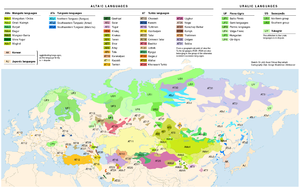This article is written like a personal reflection, personal essay, or argumentative essay that states a Wikipedia editor's personal feelings or presents an original argument about a topic. (January 2024) |
| Ural-Altaic | |
|---|---|
| Turanian | |
| (obsolete as a genealogical proposal) | |
| Geographic distribution | Eurasia |
| Linguistic classification | convergence zone |
| Subdivisions | |
| Language codes | |
| Glottolog | None |
 Distribution of Uralic, Altaic, and Yukaghir languages | |
Ural-Altaic, Uralo-Altaic, Uraltaic, or Turanic is a linguistic convergence zone and abandoned language-family proposal uniting the Uralic and the Altaic (in the narrow sense) languages. It is now generally agreed that even the Altaic languages do not share a common descent: the similarities between Turkic, Mongolic and Tungusic are better explained by diffusion and borrowing.[1][2][3][4] Just as in Altaic, the internal structure of the Uralic family has been debated since the family was first proposed.[5] Doubts about the validity of most or all of the proposed higher-order Uralic branchings (grouping the nine undisputed families) are becoming more common.[5][6][7][full citation needed] The term continues to be used for the central Eurasian typological, grammatical and lexical convergence zone.[8]
Indeed, "Ural-Altaic" may be preferable to "Altaic" in this sense. For example, J. Janhunen states that "speaking of 'Altaic' instead of 'Ural-Altaic' is a misconception, for there are no areal or typological features that are specific to 'Altaic' without Uralic."[9] Originally suggested in the 18th century, the genealogical and racial hypotheses remained debated into the mid-20th century, often with disagreements exacerbated by pan-nationalist agendas.[10]
The Ural-Altaic hypothesis had many proponents in Britain.[11] Since the 1960s, the proposed language family has been widely rejected.[12][13][14][15] A relationship between the Altaic, Indo-European and Uralic families was revived in the context of the Nostratic hypothesis, which was popular for a time,[16] with for example Allan Bomhard treating Uralic, Altaic and Indo-European as coordinate branches.[17] However, Nostratic too is now rejected.[9]
- ^ "While 'Altaic' is repeated in encyclopedias and handbooks most specialists in these languages no longer believe that the three traditional supposed Altaic groups, Turkic, Mongolian and Tungusic, are related." Lyle Campbell & Mauricio J. Mixco, A Glossary of Historical Linguistics (2007, University of Utah Press), pg. 7.
- ^ "When cognates proved not to be valid, Altaic was abandoned, and the received view now is that Turkic, Mongolian, and Tungusic are unrelated." Johanna Nichols, Linguistic Diversity in Space and Time (1992, Chicago), pg. 4.
- ^ "Careful examination indicates that the established families, Turkic, Mongolian, and Tungusic, form a linguistic area (called Altaic)...Sufficient criteria have not been given that would justify talking of a genetic relationship here." R.M.W. Dixon, The Rise and Fall of Languages (1997, Cambridge), pg. 32.
- ^ "...[T]his selection of features does not provide good evidence for common descent" and "we can observe convergence rather than divergence between Turkic and Mongolic languages—a pattern than is easily explainable by borrowing and diffusion rather than common descent", Asya Pereltsvaig, Languages of the World, An Introduction (2012, Cambridge) has a good discussion of the Altaic hypothesis (pp. 211-216).
- ^ a b Marcantonio, Angela (2002). The Uralic Language Family: Facts, Myths and Statistics. Publications of the Philological Society. Vol. 35. Oxford: Blackwell. pp. 55–68. ISBN 978-0-631-23170-7. OCLC 803186861.
- ^ Salminen, Tapani (2002). "Problems in the taxonomy of the Uralic languages in the light of modern comparative studies".
- ^ Aikio 2022, pp. 1–4.
- ^ BROWN, Keith and OGILVIE, Sarah eds.:Concise Encyclopedia of Languages of the World. 2009. p. 722.
- ^ a b Stefan Georg (2017) "The Role of Paradigmatic Morphology in Historical, Areal and Genealogical Linguistics: Thoughts and Observations in the Margin of Paradigm Change in The Transeurasian languages and Beyond (Robbeets and Bisang, eds.)." Journal of Language Contact, volume 10, issue 2, p.
- ^ Sinor 1988, p. 710.
- ^ George van DRIEM: Handbuch der Orientalistik. Volume 1 Part 10. BRILL 2001. Page 336
- ^ Colin Renfrew, Daniel Nettle: Nostratic: Examining a Linguistic Macrofamily - Page 207, Publisher: McDonald Institute for Archaeological Research, University of Cambridge(1999), ISBN 9781902937007
- ^ Trask, Robert Lawrence (2000). The Dictionary of Historical and Comparative Linguistics. Psychology Press. p. 357. ISBN 9781579582180.
- ^ Lars Johanson, Martine Irma Robbeets : Transeurasian Verbal Morphology in a Comparative Perspective: Genealogy, Contact, Chance -PAGE: 8. Publisher: Otto Harrassowitz Verlag (2010), ISBN 9783447059145
- ^ Ladislav Drozdík: Non-Finite Relativization. A Typological Study in Accessibility. Page 30 (XXX), Publisher: Ústav orientalistiky SAV, ISBN 9788080950668
- ^ Carl J. Becker: A Modern Theory of Language Evolution - Page 320, Publisher iUniverse (2004), ISBN 9780595327102
- ^ Bomhard, Allan R. (2008). Reconstructing Proto-Nostratic: Comparative Phonology, Morphology, and Vocabulary, 2 volumes. Leiden: Brill. ISBN 978-90-04-16853-4